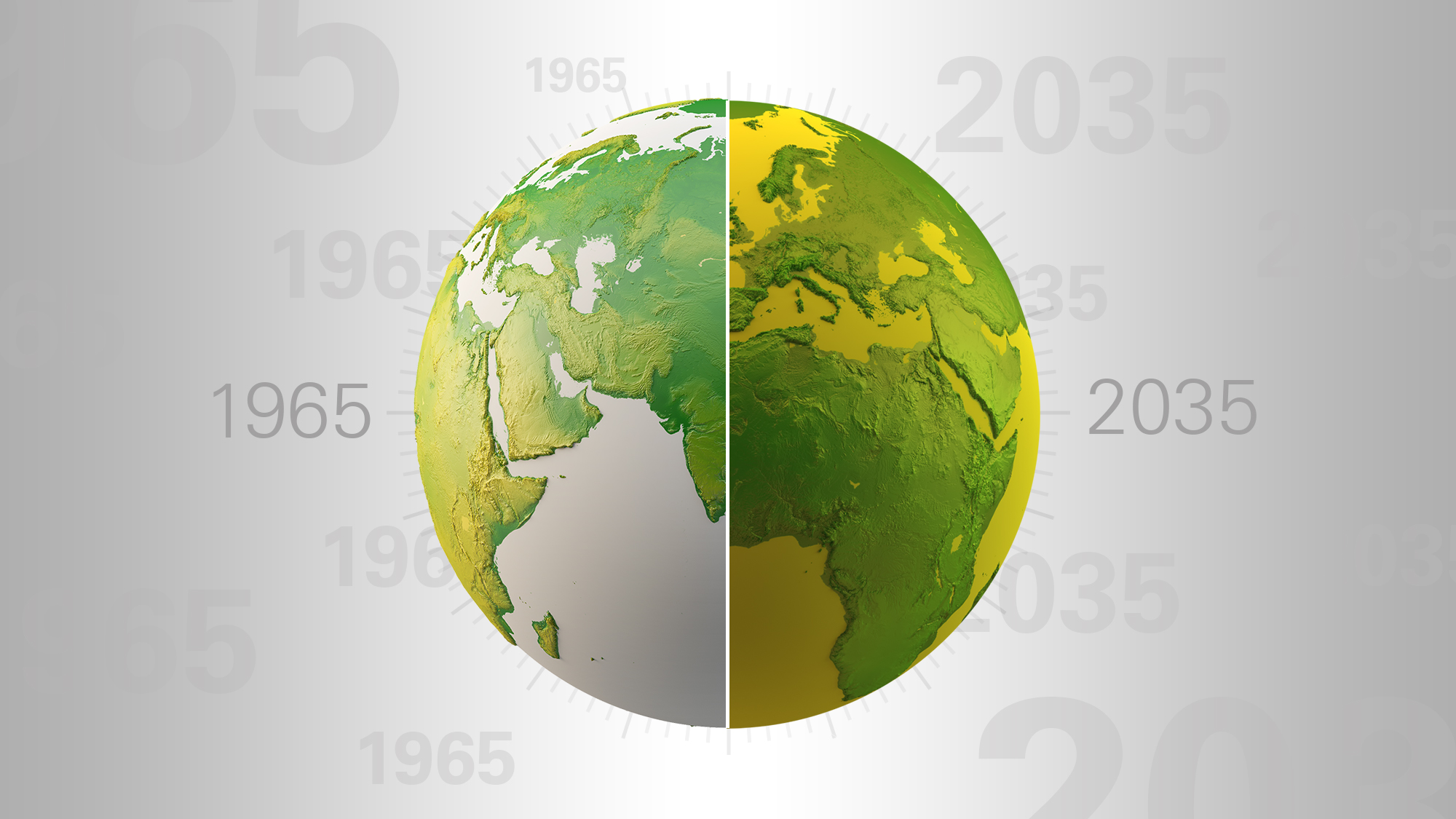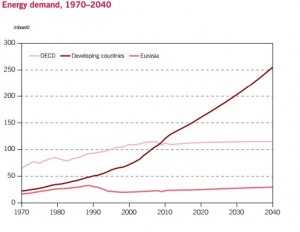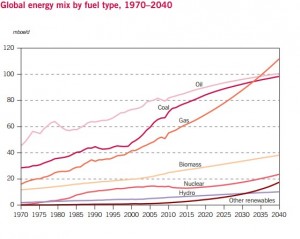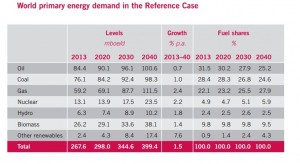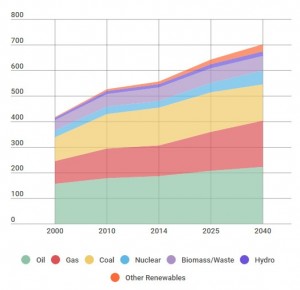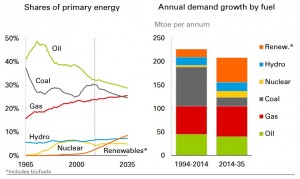By Athanasios Pitatzis
It was first on OilVoice at 9th of June 2016, http://www.oilvoice.com/n/Global-Future-Energy-Mix-Fossil-Fuels-VS-Alternative-Sources-of-Energy/6518c1922c06.aspx
U.S Energy Information Administration (EIA) Estimations
In the report International Energy Outlook 2016 U.S Energy Information Administration (EIA) predicts that the main factors that can affect the future global energy mix are:
- Economic growth in key economies (China, Brazil, Russia, among others).
- Implementation and strength of climate policies.
- Technology improvement rates (both supply and demand).
- Unrest in oil producing countries.
- OPEC production.
- Future of nuclear-generating capacity.[1]
World Energy Consumption by energy source 1990-2040, Source: International Energy Outlook 2016-World energy demand and economic outlook – U.S Energy Information Administration. Retrieved May 12, 2016, from http://www.eia.gov/forecasts/ieo/world.cfm
According to the above graph the share of:
- Petroleum Liquids will be 30% of the global future energy mix until 2040
- Natural Gas will be 26% of the global future energy mix until 2040
- Coal will be 22% of the global future energy mix until 2040
- Renewables will be 17% of the global future energy mix until 2040
- Nuclear will be 6% of the global future energy mix until 2040
Based on the above statistics, according to EIA in 2040 fossil fuels (Petroleum Liquids, Natural Gas and Coal) will account for 78% of total world energy consumption.
Organization of the Petroleum Exporting Countries (OPEC) Estimations
In the report World Oil Outlook 2015, OPEC estimates that by 2040 global energy demand will increase by 49%, from 268 mboe/d in 2013 to 399 mboe/d. Future global demand for energy according to OPEC is affected by many factors, these are:
- Technology
- Laws
- Regulations
- Macroeconomic trends
- Development processes
- Global prices
- Population size and
- Levels of urbanization.[2]
Global Energy Demand 1970 – 2040, Source: OPEC: World Oil Outlook 2015. Retrieved May 24, 2016, from http://www.opec.org/opec_web/en/publications/340.htm
Based on the below information and graphs, OPEC predicts that Fossil Fuels will continue to dominate the global energy mix at almost 78% by 2040.
Global Energy mix by fuel type 1970 – 2040, Source: OPEC: World Oil Outlook 2015. Retrieved May 24, 2016, from http://www.opec.org/opec_web/en/publications/340.htm
World primary future energy demand, Source: OPEC: World Oil Outlook 2015. Retrieved May 24, 2016, from http://www.opec.org/opec_web/en/publications/340.htm
Exxon Mobil Estimation
Furthermore, the main outcomes from a recent report from Exxon Mobil about the future global energy demand are:
- Global demand for energy rises by 25 percent 2014-2040
- Demand could have more than doubled without efficiency gains
- All demand growth comes from developing world, but China plateaus around 2030
- Demand in OECD32 falls by 5 percent 2014-2040.[3]
World Future Energy Demand (Quadrillion BTUs) by region, Source: The Outlook for Energy 2016 Version | ExxonMobil. Retrieved May 13, 2016, from http://corporate.exxonmobil.com/en/energy/energy-outlook
The same report from Exxon Mobil predicts about future global energy mix that:
- Oil remains the world’s top fuel, but natural gas grows the most
- Oil remains essential to transportation and chemicals
- Gas overtakes coal, driven by need for cleaner, reliable fuel
- Nuclear, renewables see strong growth; total more than 20 percent of supply by 2040
- All energy sources needed to meet rising demand to 2040 and beyond.3
Some other future energy trends in this report from Exxon Mobil are:
- 40% of the growth in global energy demand from 2014-2040 is projected to be met by natural gas.
- 1/3 of the world’s energy is expected to be provided by oil in 2040.
- In 2014, there were about 10 cars per 100 people in China. By 2040, this is expected to rise to about 30.[3]
Global Future Energy Mix, Source: The Outlook for Energy 2016 Version | ExxonMobil. Retrieved May 13, 2016, from http://corporate.exxonmobil.com/en/energy/energy-outlook
Until 2040, according to the report the Outlook for Energy 2016 Version from Exxon Mobil the future electricity generation trends are:
- World shifting to cleaner fuels for electricity generation, led by gas
- Coal’s share to shrink while natural gas, nuclear, wind and solar gain
- Coal provides about 30 percent of world’s electricity in 2040, vs. 40 percent in 2014
- Wind and solar will provide more than 10 percent of electricity by 2040, vs. 4 percent in 2014
- Shift to cleaner fuels driven by tighter CO2 emissions and air quality policies.[3]
British Petroleum Estimation
According to the report BP Energy Outlook for the year 2016, until 2035 the annual demand growth for:
- Oil will be 0.9%
- Natural Gas will be 1.8%
- Coal will be 0.5%
- Nuclear will be 1.9%
- Hydro will be 1.8%
- Renewables will be 6.6%. [4]
In the same report BP predicts that the future global energy mix is changing significantly, the key changes will be:
- Oil future share in global future energy mix is decreasing
- The combined increase of oil and gas over the Outlook is similar to the past 20 years
- Coal share in the global future energy mix will decline slightly
- Fossil Fuels will remain the primary source of energy until 2035 with a share of 80% of the future global energy mix
- Renewables share will increase from 3% today to 9% by 2035. [4]
Global Future Energy Mix, Source: Outlook to 2035 – energy use to rise by a third | BP Energy Outlook | Energy economics | BP Global. Retrieved May 15, 2016, from http://www.bp.com/en/global/corporate/energy-economics/energy-outlook-2035/energy-outlook-to-2035.html
Conclusion
Oil and Gas Share in the future global energy mix, Source: EIA, OPEC, BP and Exxon Mobil
Based on the above chart, the oil and gas proportion in the future global energy mix until 2035-2040 will be between 53 – 58%, which guarantees the business future of global oil and gas companies but in a business environment with restricted rules about environmental footprint.
Athanasios Pitatzis is an Industrial/Petroleum Engineer and Member of the Greek Energy Forum. He specializes in the development of oil & gas markets in Southeast Europe and the Mediterranean. Also, he is the owner of the website Energy Routes in which he publishes all of his articles for global oil and gas industry, http://energyroutes.eu/ The opinions expressed in the article are personal and do not reflect the views of the entire forum or the company that employs the author. Follow Greek Energy Forum on Twitter at @GrEnergyForum and Athanasios at @thanospitatzis.
References
[1] International Energy Outlook 2016-World energy demand and economic outlook – U.S Energy Information Administration. Retrieved May 12, 2016, from http://www.eia.gov/forecasts/ieo/world.cfm
[2] OPEC: World Oil Outlook 2015 Edition. Retrieved February 24, 2016, from http://www.opec.org/opec_web/en/publications/340.htm
[3] The Outlook for Energy 2016 Version | ExxonMobil. Retrieved May 13, 2016, from http://corporate.exxonmobil.com/en/energy/energy-outlook
[4] Outlook to 2035 – energy use to rise by a third | BP Energy Outlook | Energy economics | BP Global. Retrieved May 15, 2016, from http://www.bp.com/en/global/corporate/energy-economics/energy-outlook-2035/energy-outlook-to-2035.html

